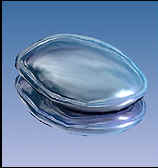|
Menu
|
Platinum |
| Reaction of
Platinum
Platinum does not normally react with air or water. Reaction of platinum with the halogens Careful control of the reaction between platinum metal and fluorine gas gives either the volatile platinum(VI) fluoride, PtF6 or the tetrameric platinum(V) fluoride, (PtF5)4. The latter product disproportionates into platinum(VI) fluoride and platinum(IV) fluoride, PtF4. Pt(s) + 3F2(g) 4Pt(s) + 10F2(g) (PtF5)4(s) PtCl4, PtBr4 and PtI4 are formed in the reactions of platinum metal and chlorine, Cl2, bromine, Br2, or iodine, I2. Pt(s) + 2Cl2(g) Pt(s) + 2Br2(g) Pt(s) + 2I2(g) PtCl2 is also formed in the controlled reaction of platinum metal and chlorine. Depending upon the reaction conditio9ns, one of two different forms of PtCl2 is formed. Pt(s) + Cl2(g) |
